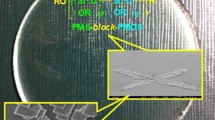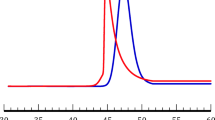Abstract
New silane monomers with the pendant 4-(3-pyridine)butyl group have been synthesized by hydrosilation of 3-(3-butenyl)pyridine with Me n Si(OEt)3-n H (n=0, 1) using a platinum catalyst. Only β-addition products were observed. The products were characterized by elemental analysis, infrared,1H- and13C-NMR spectroscopy, and gas chromatography-mass spectrometry. Hydrolysis-polycondensation of the difunctional monomer with a basic catalyst, Me4NOH, gave a mixture of cyclic oligomers, principally cyclic tetramer, and linear homopolymer. Under similar reaction conditions, the trifunctional monomer gave crosslinked material which was soluble in common organic solvents. The linear homopolymer and crosslinked polymer were trimethylsilyl end-blocked with hexamethyldisilazane. The cyclic and end-blocked polymers were characterized by elemental analysis and spectroscopic methods. Molecular weights of the polymers were obtained by end-group analysis using1H-NMR spectral data, size exclusion chromatography, and direct insertion-probe mass spectrometry. The cyclic, linear, and crosslinked materials were N-oxidized withm-chloroperoxybenzoic acid and characterized by spectroscopic methods. The polymeric N-oxide derivatives were shown to be effective transacylation catalysts in the synthesis of mixed carboxylic acid anhydrides in immiscible solvents (H2O/CH2Cl2) under phase-transfer conditions. The implications of the results on the mechanism of catalysis are discussed.
Similar content being viewed by others
References
W. K. Fife and Y. Xin,J. Am. Chem. Soc. 109, 1278 (1987).
W. K. Fife and Z.-d. Zhang,J. Org. Chem. 51, 3744 (1986).
W. K. Fife and Z.-d. Zhang,Tetrahedron Lett. 27, 4933 (1986).
W. K. Fife and Z.-d. Zhang,Tetrahedron Lett. 27, 4937 (1986).
L. J. Mathias and R. A. Vaidya,J. Am. Chem. Soc. 108, 1093 (1986).
E. G. Rochow,Silicon and Silicones (Springer-Verlag, Berlin, 1987).
M. Zeldin, W. K. Fife, C.-x. Tian, and J.-m. Xu,Organometallics 7, 470 (1988).
S. Rubinsztajn, M. Zeldin, and W. K. Fife,Macromolecules 23, 4026 (1990).
M. Zeldin, W. K. Fife, C.-x. Tian, and Y. Xin,Brit. Polym. J. 21, 481 (1989).
D. G. Anderson, M. A. M. Bradney, and D. E. Webster,J. Chem. Soc. B 450 (1968).
A. Fischer and M. W. Morgan,J. Organomet. Chem. 136, 323 (1977).
E. W. Petrillo, private communication, Bristol-Myers Squibb Pharmaceutical Research Institute [see D.S. Karanewsky, M.C. Badia, D.W. Cushman, J.M. DeForrest, T. Dejneka, M. J. Loots, M. G. Perri, R. W. Pertrillo, Jr., and J. R. Powell,J. Med. Chem. 31, 204 (1988).
E. M. Kaiser and J. D. Petty,Synthesis 705 (1975).
C. J. Pouchert and J. R. Campbell,The Aldrich Library of NMR Spectra, Vol. IX (Aldrich Chemical, Milwaukee, 1974).
A. R. Katritzky,Handbook of Heterocyclic Chemistry (Pergamon Press, New York, 1985).
K. A. Andrianov, G. P. Bochkareva, and M. A. Golubenko,Zh. Obshch. Khim. 37(2), 398 (1967).
J. L. Speier,Advances in Organometallic Chemistry 17, 407 (1979).
A. L. Smith,Analysis of Silicones (Wiley, New York, 1974).
P. J. Launer, inSilicon Compounds Register and Review (Petrarch Systems, Bristol, PA, 1987), p. 69.
L. Wilczek, S. Rubinsztajn, and J. Chojnowski,Macromol. Chem. 187, 39 (1986).
S. Rubinsztajn, M. Zeldin, and W. K. Fife,Macromolecules 24, 2682 (1991).
T. E. Helminiak and G. C. Berry,J. Polym. Sci. Polym. Symp. 65, 107 (1978).
G. V. Kireev, V. B. Leont'ev, Y. V. Kurbatov, O. S. Otroshchenko, and A. S. Sadykov,Izv. Akad. Nauk SSSR Ser. Khim. 5, 1034 (1980).
H. Shindo,Chem. Pharm. Bull. (Tokyo) 6, 117 (1958).
C.-s Kuo and J.-j. Jwo,J. Org. Chem. 57, 1991 (1992).
Author information
Authors and Affiliations
Rights and permissions
About this article
Cite this article
Zeldin, M., Granger, E. & Fife, W.K. Synthesis, characterization, and catalytic properties of polysiloxanes with pendant 4-(3-pyridinyl)butyl and 4-(1-oxypyridin-3-yl)butyl groups. J Inorg Organomet Polym 3, 141–154 (1993). https://doi.org/10.1007/BF00683792
Received:
Revised:
Issue Date:
DOI: https://doi.org/10.1007/BF00683792




